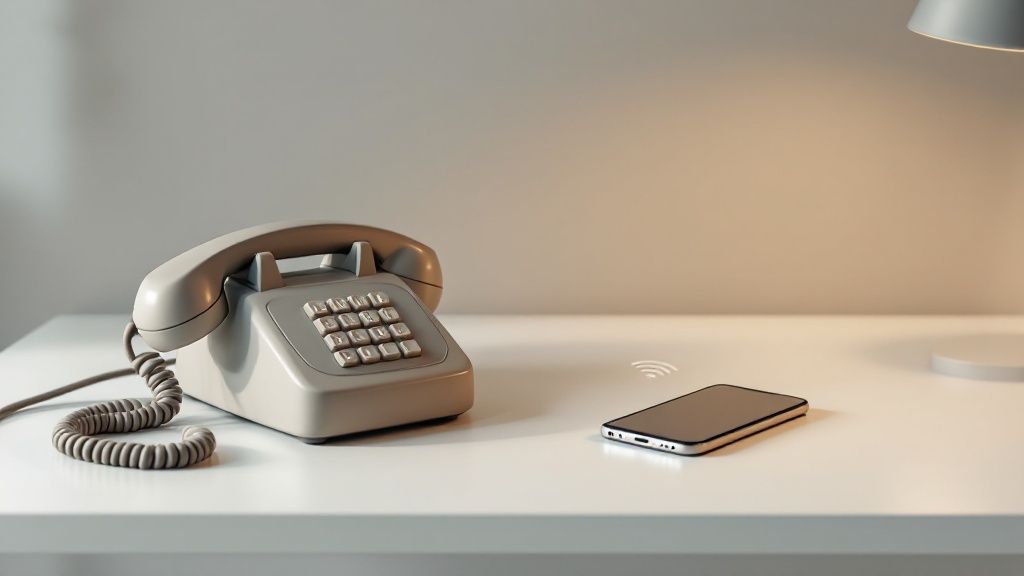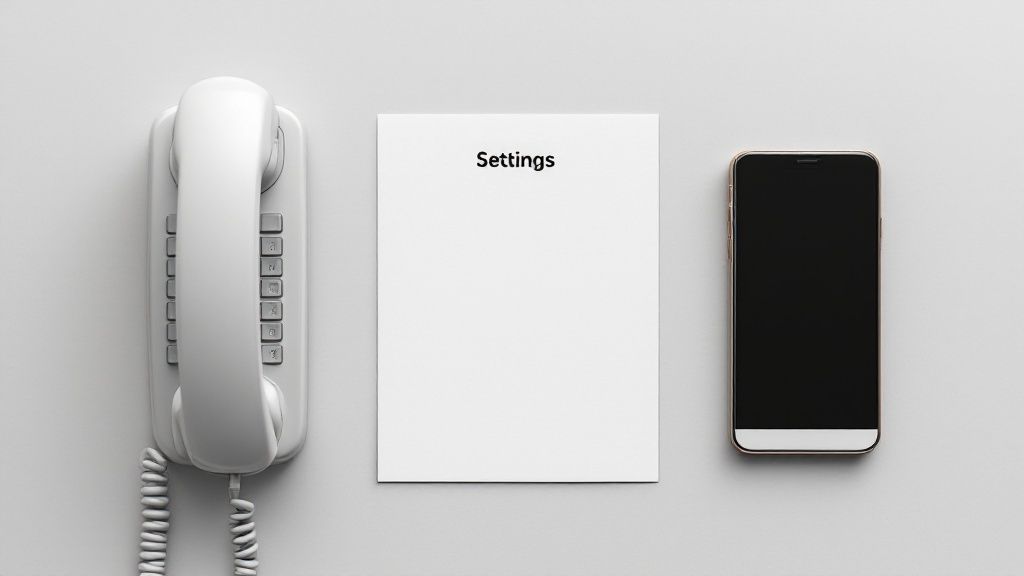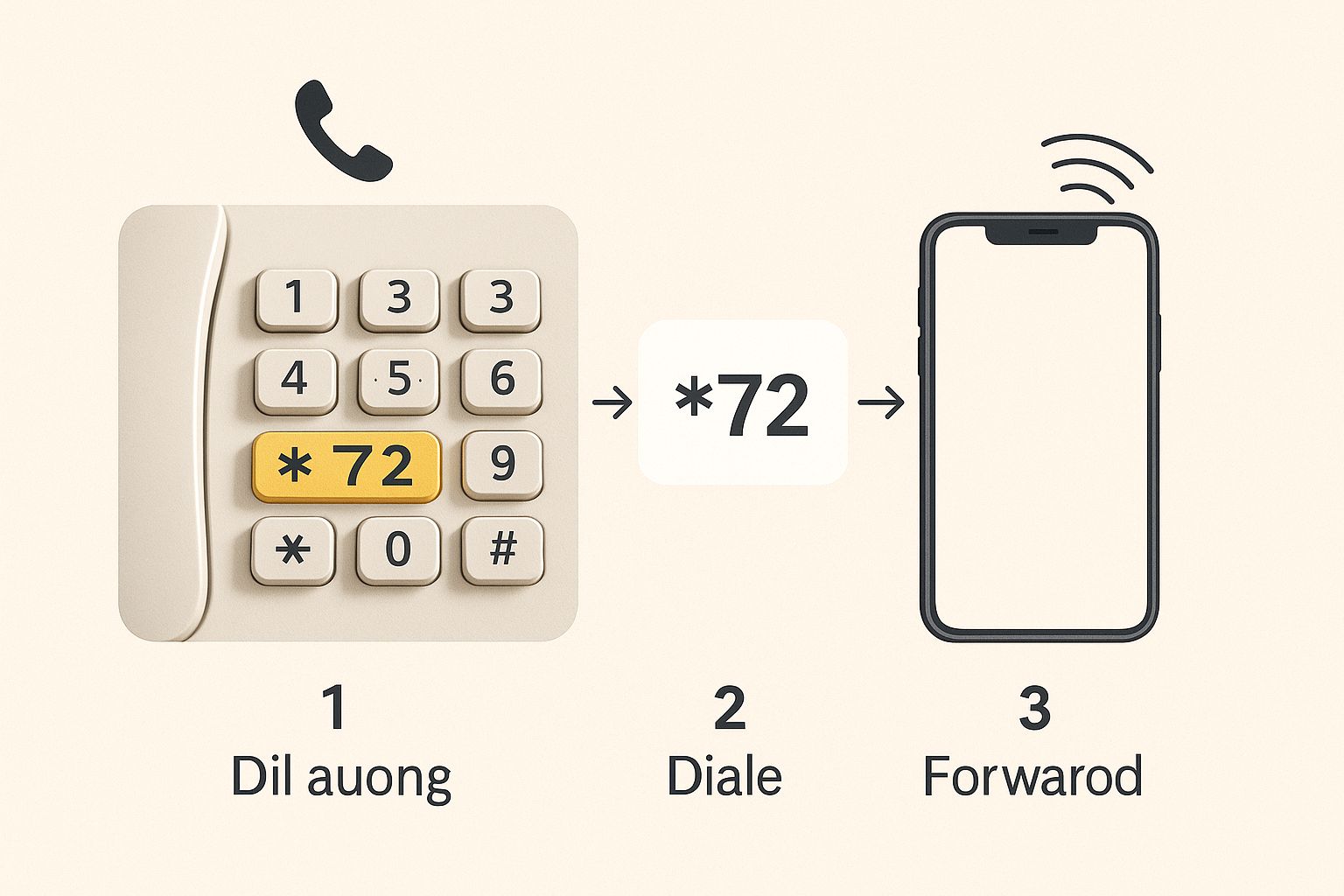Tired of being chained to your desk, just waiting for the phone to ring? Forwarding your landline to your mobile is the answer, and it’s a lot easier than you might think. It’s a simple process that redirects all your incoming landline calls straight to your mobile phone. This means you’ll never miss an important conversation, whether you're out on-site with a client or grabbing a coffee.
Why Forwarding Your Landline Is a Game Changer

In a world that expects you to be available 24/7, a stationary landline can feel like an anchor holding your business back. For small business owners here in Australia, every single missed call can be a lost opportunity.
That’s where figuring out how to forward calls from a landline to a mobile becomes a crucial business strategy, not just a tech trick. It turns your traditional, old-school phone line into a flexible, modern tool that works for you.
This one simple change offers some massive practical benefits that go way beyond just convenience. It closes the gap between the reliability of your landline number and the mobility your work actually demands.
Think about it: a tradie being able to take a new job inquiry while on-site, or a real estate agent finalising a deal from their car. That's the kind of freedom call forwarding delivers.
Unlocking Professional Freedom
Being able to step away from a physical location while keeping up a professional front is invaluable. It makes sure clients can always reach you on the number they trust, and they'll never even know you're not at your desk. It’s a seamless experience that builds credibility and seriously improves customer service.
Some of the key advantages are pretty clear:
- Enhanced Mobility: You can answer calls from absolutely anywhere, ensuring you’re always connected to your clients and your team.
- Never Miss a Lead: It helps you capture every single business opportunity, even when you’re out of the office.
- Improved Professional Image: You get to maintain a consistent business landline number while enjoying the flexibility of your mobile.
The Modern Business Imperative
This shift lines up perfectly with the bigger business trends that are all about mobility and staying connected. For Aussie businesses, especially those with a team that's always on the move, forwarding landline calls to mobiles is critical for keeping communication flowing without a hitch.
By getting your head around what call forwarding is and why it's so important strategically, you can make a smart decision that will boost your efficiency and make you more responsive to your customers.
Choosing Your Call Forwarding Method

When you're looking at how to forward calls from a landline to a mobile, you’ll quickly find there are two main ways to do it here in Australia. Figuring out which path to take really comes down to what you’re trying to achieve. Is this just a quick fix for an afternoon out of the office, or are you after a more permanent, professional setup?
One route is the classic method using special dialling codes—often called 'star codes'—which you get directly from your landline provider like Telstra or Optus. It's a very direct and fast way to get basic call diversion up and running.
The other path involves modern, cloud-based virtual phone services. These aren't just about forwarding calls; they're complete communication systems packed with powerful features built for professionals and growing businesses who need a bit more muscle than a simple redirect.
Traditional Star Codes
Think of star codes as the old-school manual override for your phone line. You dial a specific sequence of numbers, and you're telling the network to send every single incoming call straight to your mobile. It's an effective, no-frills solution when you just need to duck out for a bit.
But that simplicity is also its biggest drawback. You usually have to be physically at your landline phone to switch it on and off. There are no advanced features like setting business hours or playing a custom greeting for your callers. It’s a bit of a blunt instrument—it's either all on or all off.
Modern Cloud-Based Forwarding
On the flip side, cloud-based services offer a system that's far more flexible and powerful. Instead of your number being physically tied to a copper line, it lives in the cloud and you manage everything through an app or an online dashboard. This is really how modern call forwarding from landlines to mobiles is done in Australia today.
The setup is surprisingly quick, too. Most providers can port your existing landline number over to their platform, often within a single business day, so you can ditch the clunky on-site telephone gear. You can dig deeper into how these cloud-based services work via TNZ.com.au.
This method basically transforms your static landline number into a dynamic business tool. You get the power to set up smart routing rules, create professional welcome greetings, and even have your voicemails transcribed and emailed straight to you.
Deciding between the two can be tricky, so let's break it down with a quick comparison.
Comparing Call Forwarding Methods
The table below gives you a side-by-side look at how old-school star codes stack up against a modern cloud-based approach. It helps highlight the key differences in flexibility, features, and how you manage everything.
| Feature | Traditional Forwarding (Star Codes) | Cloud-Based Forwarding (Virtual Number) |
|---|---|---|
| Setup Process | Dial a code from your landline | Online sign-up and number porting |
| Flexibility | Basic on/off functionality | Highly customisable with rules, hours, etc. |
| Advanced Features | None | Voicemail-to-email, call screening, analytics |
| Management | Physical access to the phone required | Manage from anywhere via app or web |
| Best For | Occasional, temporary call diversion | Professionals and businesses needing control |
At the end of the day, if you just need a simple redirect for a short time, star codes will get the job done. But for anyone running a business or needing professional-grade communication tools, a cloud-based service is the clear winner. It gives you the kind of control and features a traditional landline simply can't compete with.
Using Star Codes for Basic Call Forwarding
For a quick, no-fuss way to get your landline calls ringing on your mobile, star codes are the classic, hands-on solution. Most Aussie telcos support this method, which is as simple as dialling a specific sequence of numbers right from your landline handset. No apps to download, no accounts to log into—it's an immediate command you give directly to the phone network.
This is perfect for those temporary situations. Say you need to duck out of the office for a few hours but can't risk missing that important call. It's a straightforward approach that just gets the job done.

As you can see, it really is just a few button presses to link your two devices and stay connected wherever you are.
Forwarding All Calls Unconditionally
This is the one most people think of, often called unconditional call forwarding. Flick this on, and every single call that comes to your landline will instantly ring on your mobile instead. Your landline won't even make a peep.
To get this going, you'll generally use the code *21*.
- To turn it on: Pick up your landline, dial *21* followed by your mobile number, and then hit #. For example, you’d dial
*21*0412345678#. - To turn it off: Ready for calls to hit your landline again? Just dial #21#.
Forwarding When Your Line Is Busy
What happens if you're already on a landline call and another one tries to come through? Instead of the caller getting a frustrating busy signal, you can have that second call sent straight to your mobile. It's a brilliant way to make sure you don't miss a new lead just because you're busy helping another client.
The standard code for this is *67*.
This conditional forwarding is a subtle but powerful feature. It creates a seamless backup, making your single landline feel more like a professional multi-line system—without any extra cost or complicated gear.
To enable it, just dial *67* followed by your mobile number and #. When you want to disable it, the deactivation code is usually #67#. For a deeper dive into these kinds of scenarios, you might want to check out our guide on how you divert a home phone to a mobile.
Forwarding If You Don't Answer
Sometimes you're right there in the office but just can't get to the phone in time. This option is your saviour. It lets the call ring on your landline for a set period (usually about 15-20 seconds) before it automatically gives up and forwards to your mobile. It gives you a fair chance to answer at your desk first.
The code for this one is typically *61*.
- To activate: Dial *61*, then your mobile number, followed by #.
- To deactivate: To cancel it and go back to normal, simply dial #61#.
These star codes give you some really handy, fundamental control over your call flow. They're a valuable tool for anyone needing a simple, immediate solution for forwarding their landline.
How to Set Up Cloud-Based Call Forwarding
If you're finding that dialling star codes is a bit too old-school for your business, making the jump to a cloud-based service is the natural next step. This move basically takes your landline number and turns it into a powerful, flexible tool you can manage from literally anywhere. It sounds more complicated than it is, but it opens up a whole world of professional features.
The idea is pretty straightforward: your landline number is no longer chained to a physical copper wire in the ground. Instead, it lives online, and you control it through a simple dashboard or an app. This gives you total command over how to forward calls from a landline to a mobile, and a whole lot more.
Making the Switch to the Cloud
The first thing you’ll do is pick an Australian virtual phone number provider. Right off the bat, you'll need to decide whether to port your existing landline number or just get a new one. Porting is great for established businesses because you get to keep the number your customers already know and trust. For a startup, grabbing a new number can be quicker and easier.
Once you're signed up, the real fun begins inside the online dashboard. This is your command centre, and it lets you set up all sorts of things that are just impossible with a traditional landline. For any business wanting to get serious about call forwarding, understanding how a modern cloud phone service works is a must.
Unlocking Advanced Control and Professionalism
Imagine setting up your business hours so that any calls between 9 AM and 5 PM get forwarded straight to your mobile, but after-hours calls go directly to a professional voicemail. That kind of automation is a complete game-changer for a small operation.
With a cloud-based system, you're not just forwarding calls; you're building a smarter, more responsive communication strategy. It’s about creating a seamless and professional experience for every single caller.
Here are just a few of the powerful features you can usually get your hands on:
- Custom Welcome Greetings: Record a polished message to greet callers before their call even connects.
- Voicemail-to-Email: Get voicemail recordings and even transcripts sent straight to your inbox. It makes follow-ups so much faster.
- Intelligent Call Routing: You can direct calls based on the time of day, who’s calling, or even by setting up a simple menu (like, "Press 1 for sales, press 2 for support").
This modern approach gives you a robust and professional communication system that travels with you. Exploring a dedicated cloud phone system is the key to making sure your business looks polished and professional, no matter where you happen to be working from.
Running into Call Forwarding Problems?
Even the simplest tech can throw a curveball sometimes. If you’ve followed the steps to set up call forwarding and it’s just not playing ball, don’t stress—the fix is usually pretty straightforward. We’ve all been there: you punch in the star code and get nothing, or worse, calls are bee-lining to voicemail instead of your mobile.
Before you spend an age on hold with your provider, let’s run through a quick diagnostic. A common culprit is that the call forwarding feature isn't actually switched on for your plan. It might seem obvious, but some providers require you to opt-in or activate it on their end first.
Check Your Numbers and Settings
Nine times out of ten, a simple typo is the real villain. When you’re punching in the number you want to forward calls to, it’s easy to get a digit wrong. Double-check that it’s correct and complete.
Here in Australia, the format for call forwarding is quite specific. For a landline to successfully redirect to a mobile, the mobile number must start with the ‘04’ prefix, followed by the usual eight digits. Getting this format right is critical for the system to work.
If you’ve checked the number and you're still stuck, here are a couple of other things to try:
- Do a quick reset. Sometimes the system just needs a nudge. Turn the forwarding off completely with the deactivation code (like #21#), give it a minute, and then try setting it all up again from scratch.
- What’s your mobile reception like? If your mobile is in a spot with a dodgy signal, the forwarded call might not be able to get through. Instead of ringing, it’ll likely fail or just give up and go straight to voicemail.
If you find you’re getting dropped or missed calls after you’ve got forwarding working, it might be time to look at how to improve your cell phone reception. A weak signal is often the weakest link in the chain.
Got Questions About Call Forwarding?
Still got a few things you're wondering about when it comes to forwarding your landline to a mobile? No worries. Here are some quick answers to the questions we hear most often from Aussies just like you.
How Much Does Call Forwarding Cost?
The cost can really vary. If you’re with a traditional provider like Telstra, you might be looking at a small monthly fee on top of per-minute rates for the forwarded leg of the call. It can add up.
On the other hand, more modern cloud-based services usually bundle it all into a flat monthly subscription. This often includes a generous amount of minutes, which makes your monthly bill far more predictable.
Can I Forward Calls From an NBN Phone Line?
Yep, you absolutely can. Since NBN phone lines run on internet technology (VoIP), call forwarding is a standard feature right out of the box. You’ll typically manage it through your provider's online portal instead of punching in the old star codes on your handset.
For the person dialling your number, the whole experience is completely seamless. They'll just hear a standard ringtone and have no idea their call is being cleverly rerouted to your mobile.
Ready to stop missing calls and start managing them intelligently? OnSilent’s AI Call Assistant filters spam, organises your messages, and saves you hours every week. Discover how OnSilent can transform your call management today.

